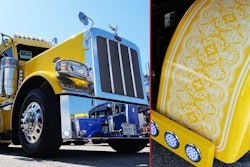Do-it-yourself cooling system flushes might loosen sediment, which will then clog radiator tubes.
Neglecting your radiator isn’t all bad. On the bright side, you’ll make new friends at the radiator shop. Of course, you’ll be losing a lot of money at the same time. “Without care, a radiator might last a couple of years, if you’re just running up and down the highway,” says Doug Covey, owner of Covey’s Radiator Service in West Palm Beach, Fla. “But if you’re running off-road a lot, you could have your plastic tanks cracking within a year.”
That’s how Covey’s customers get to know him. “They just drive until it’s a problem or until it breaks,” he says. “Then they bring it here and have it fixed.”
It doesn’t take much – no highly technical skills or tools – to stay on top of the condition of your radiator and antifreeze and avoid a premature visit to the shop.
Near coastal areas, the salt air destroys poorly maintained radiators year-round, says Covey, who for 20 years has been running the radiator service his father started 35 years ago. Up north, drivers have to watch out for the highly corrosive chemicals spread on highways during winter.
“The liquid calcium and sodium chloride that they mix with the salt just tears trucks up,” says Brian Sollenberger, shop manager at West Side Radiator Repair in Denver, Pa. The damage can occur fairly quickly.
“I’ve replaced radiators on ’04 trucks,” Sollenberger says. “We have guys coming in after just one year with no fins on their radiators.”
But it doesn’t have to be that way, he says. “There’s a guy in Reading (Pa.) whose fleet delivers heating oil, so he runs hard during the winter,” Sollenberger says. “He’s running 30-year-old radiators.”
Sollenberger attributes their longevity to regular maintenance. “He inspects mounting brackets and bushings to help keep the vibrations down. He keeps his radiators washed and painted with good antifreeze inside.”
Radiators were made of thicker metal decades ago, Sollenberger says. “I’ve repaired core leaks on radiators from the 1920s and ’30s,” he says. “They used to build them a lot better then.” But even today, he says, “They’ll last as long as there’s somebody who’ll keep them washed and painted.”
Today’s truck radiators are made of plastic and aluminum, brass and copper, or, in some cases, steel. “Most of the newer trucks – after ’87 or ’88 – have radiators with aluminum cores and plastic tanks,” says Gary Darnell, owner of Radiator Works in Riverview, Mich. “That’s what put us in business. The vibration and heat crack the tanks, and the gaskets leak.”
Covey is familiar with that problem. “If you look at the engines now, they have those big hoses attached to the necks on those plastic tanks,” Covey says. “Those hoses are otherwise unsupported, so the plastic is the only thing holding them up. The plastic gets weak and brittle from the expanding and contracting, necks crack, and then you have a leak.”
A thorough radiator preventive maintenance program starts with analyzing antifreeze.
“I don’t mean just sticking a hydrometer in there and checking your antifreeze level and your pH,” Sollenberger says. “I like to see owner-operators take antifreeze samples from their radiators and send them out for a chemical analysis.”
Almost any dealership service department or reputable repair shop can perform an antifreeze analysis or arrange to get one done, and the cost is low. At Kelly Tractor, a Caterpillar affiliate in Miami, a Level One antifreeze analysis costs about $10 and detects glycol percentage, pH level, conductivity, magnetic particles, foaming and contaminants such as fuel or engine or transmission oil. A Level Two analysis is much more in-depth, costs $35 to $40, and is performed at the Caterpillar headquarters in Peoria, Ill.
“An analysis will tell you about the problem,” Sollenberger says. “You have to figure out the cure.” There are more than two dozen reasons a radiator will overheat, and changing antifreeze isn’t the remedy for all of them, he says. “If the antifreeze has combustion gases in it, the technician might say it’s time to tear down the engine and see where those gases are coming from. It might show engine oil or transmission oil in your antifreeze. If it does, then you might want to do some testing to see where that oil is coming from.”
Keeping the outside of the radiator cleaned and painted is another important preventive maintenance practice. “The fins will crumble a lot faster if you leave that stuff on your radiator that splashes up from the road,” Covey says. “You have to keep the outside of your radiator washed and painted, especially if you’re driving around those chemicals or in the salty air.”
Advanced breakdown of the fins usually spells the radiator’s demise. “When the fins deteriorate, you have no support for the tubes, and eventually you’ll split a tube,” Covey says. “If there’s excess pressure on the system, you’ll blow a solder seam.”
Sollenberger recommends using a garden hose to rinse the radiator until you see no more dirt coming out from between the fins and tubes. Painting the radiator every time you clean it is unnecessary, he says, “but as soon as you see bare metal, you want to paint it.” He uses black Rustoleum spray paint.
Finally, keep the radiator full of good antifreeze, mixed 50-50 with water. Covey cautions against mixing different brands of antifreeze, which can cause a chemical reaction that damages your engine. He recommends using whatever brand the truck or engine maker recommends.
Covey suggests a yearly flushing, though most antifreeze makers recommend longer change intervals. “It depends on the kind of work you do,” Covey says. Tougher applications with high engine heat, severe vibration and extra exposure to corrosives will accelerate antifreeze breakdown and mandate frequent changes.
Fins and tubes cleaned and painted as necessary will help the radiator work better and prolong antifreeze life, as will leaks fixed early or prevented altogether.
Sollenberger recommends having the radiator checked annually or, if you operate in high-mileage applications, twice a year.
Don’t wait until problems start. “Everybody thinks flushing will solve their overheating problems,” but this only gets rid of the mud, Covey says. “Once you’re overheating, all a flush will really do is change the color of the coolant.”
A little regular attention paid to your radiator will pay off. New radiators start at about $400, depending on purchase location, type of replacement and truck make. Maintenance is cheaper and takes less time.
So analyze antifreeze and address problems detected, flush the radiator inside and out, paint as necessary, watch for leaks, and be a stranger at the radiator repair shop.
FIX OR REPLACE?
All big-truck radiators once were made of thick metal, but environmental, marketing and technology concerns have changed that – for better and for worse.
“The previous couple of years, the original equipment manufacturers have been trying to get the engines running hotter to keep the emissions down,” says Brian Sollenberger, shop manager of West Side Radiator Service in Denver, Pa. “Hotter engines run more efficiently and have more horsepower.”
Now made of thinner metal, radiator cores have more space between tubes and more fins per inch to increase cooling capacity, but the newer radiators aren’t as sturdy.
“In the old days, you could whack a deer and take 15 tubes out of your radiator and not have a problem,” Sollenberger says. “You can’t do that today.”
“With the plastic and aluminum radiators, they don’t want to re-core them,” says Gary Darnell, owner of Radiator Works in Riverview, Mich. “Once the aluminum cores start leaking or overheating, it’s time to replace them.”
Even though the cores sometimes can be fixed, replacement is often cheaper.
“Generally, a well-maintained brass or copper radiator is going to last much longer,” Darnell says. “A brass or copper radiator is going to give you the option of spending around $50 to have the leak repaired, or you can have it re-cored. That’s still cheaper than buying a new one.”
Although it can’t be re-cored, aluminum has its advantages. Compared to brass or copper cores, it’s lighter, cools better and doesn’t corrode or leak as much.
Darnell says prices can vary significantly. “In the OEM market they might sell a new radiator for $400, or they might sell it for $1,500.” New-truck dealers in the Detroit area have lowered prices to compete with the aftermarket, he says. “But as you go east, new radiator prices go way up.” Different OEMs also charge significantly varying prices for radiators.
Some OEMs still make all-metal, bolt-together radiators. They cost more, but “in the long run, it’s worth it,” Darnell says.
DO-IT-YOURSELF FLUSHING PRECAUTIONS
“A good high-pressure, reverse flush will break down a lot of dirt inside,” says Doug Covey of Covey’s Radiator Service in West Palm Beach, Fla. “You can do it yourself, but you have to buy a flush gun.”
Covey says his cost about $130. An air compressor also is needed. “You just seal the gun in the discharge, block the inlet and leave the spout open. I use whatever pressure my compressor goes to.”
But doing your own maintenance has potential pitfalls. “Some people buy the do-it-yourself kits, hook a garden hose to the heater tube and wait until the water comes out clear,” Covey says. “I don’t recommend that. In most cases it doesn’t work, and the chemicals will break down and loosen deposits in the cooling system and dirt and solder bloom in the core.” The resulting brown, sticky mass will clog the tubes.
Another pitfall of do-it-yourself cleaning is running afoul of the law. The U.S. Environmental Protection Agency says antifreeze, and the traces of lead in it from deteriorating solder, are hazardous waste requiring special disposal.








